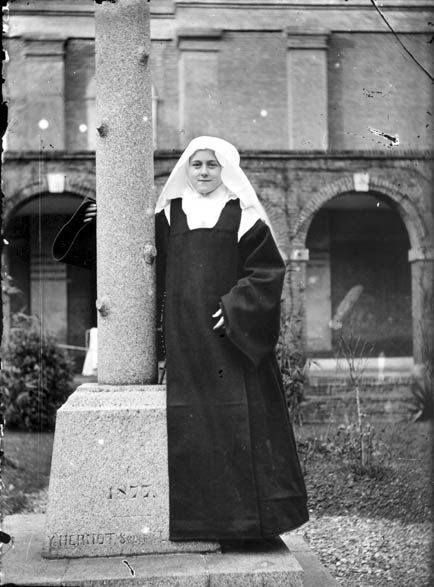Saint Thérèse of Lisieux
Feast Day: October 1
Marie Françoise Thérèse Martin, known as the Little Flower of Jesus, was born January 2, 1873 at Alençon in Normandy, France, of very Christian parents. The Martins, who lost four of their little ones in early infancy or childhood, regarded their children as gifts from heaven and offered them to God before their birth. Thérèse was the last flower of this blessed stem, which gave four Sisters to the Carmel of Lisieux, and still another to the Visitation of Caen. The five sisters were left without their mother, a victim of cancer, when Thérèse was only four years old; but her two oldest sisters were of an age to take excellent care of the household and continue the Christian character formation of the younger ones, which their mother had initiated. Their saintly father was soon to see his little flock separated, however, when one after the other they left to enter religious life. He blessed each one and gave them all back to God, with humble gratitude to God for having chosen his daughters.
From childhood, Thérèse had manifested a tender piety which her naturally lively temperament could not alter. Her mother’s death affected her profoundly, however, and at the age of nine she was visited with a severe trial in the form of an illness the doctors could not diagnose, and which seemed incurable. She was instantly restored to her ordinary good health by the Virgin Mary, in answer to her desolate sisters’ prayers; Thérèse saw Her statue become animated, to smile at her with an ineffable tenderness as she lay on her bed of suffering.
Before the age of fifteen Thérèse already desired to enter the Carmel of Lisieux, where her two eldest sisters were already nuns; a trip to Rome and a petition at the knees of the Holy Father Leo XIII gave her the inalterable answer that her Superiors would regulate the matter. Many prayers finally obtained an affirmative reply to her ardent request, and four months after her fifteenth birthday she entered Carmel with an ineffable joy. She could say then, I no longer have any desire but to love Jesus even to folly.
She adopted flowers as the symbol of her love for her Divine Spouse and offered all her little daily sacrifices and works as rose petals at the feet of Jesus. Divine Providence gave to the world the autobiography of this true Saint, whose little way of spiritual childhood was described in her own words in her Story of a Soul.
When nine years had passed in the Carmel, the little flower was ready to be plucked for heaven; and in a slow agony of consumption, Thérèse made her final offering to God. She suffered so severely that she said she would never have believed it possible, and could only explain it by her desire to save souls for God. She died in 1897, was beatified in 1923 and canonized in 1925. And now, as she foretold, she is spending her heaven in doing good upon earth. Countless miracles have been attributed to her intercession.
Patronage
Florists – Missions – Pilots – Priests
Source: sanctoral.com

Birthplace
Born
2 January 1873
Alençon, Normandy, France
Death
30 September 1897 (age 24)
Lisieux, Calvados, France
Canonized
17 May 1925 (Pope Pius XI)
Shrine/Relics/Tomb
Lisieux, France
Learn more:
Franciscan Media
Saint Therese of Lisieux – FranciscanMedia.org
Life in a Carmelite convent is indeed uneventful and consists mainly of prayer and hard domestic work. But Thérèse possessed that holy insight that redeems the time, however dull that time may be. She saw in quiet suffering a redemptive suffering…
Word On Fire
The Feast of the Little Flower – WordOnFire.org
Oct 1, 2013 — Like many Carmelite nuns before her, Thérèse’s death should have meant the culmination of a life of obscurity, freely chosen, so that one might disappear fully into the mission of the Church. Yet this particular Carmelite would prove different in this respect…
